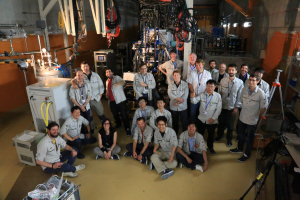An experiment led by the IFIC improves our understanding of the formation of heavy elements in the cosmos
An international team led by the Institute of Corpuscular Physics (IFIC), a joint center of the Spanish National Research Council (CSIC) and the University of Valencia (UV), has achieved a milestone in exploring the origin of the universe's matter. This team has measured, for the first time, the decay properties of 37 extremely rare and fleeting atomic nuclei that exist only for fractions of a second and are not found naturally on Earth. The work, published in the prestigious journal Physical Review Letters, provides new information to help solve one of the great mysteries of modern physics: how are elements heavier than iron formed?
The answer to this enigma points to extreme phenomena such as neutron star mergers, and the new work from IFIC provides crucial data to develop models that describe this process. The 37 atomic nuclei studied are located in an unexplored region near nickel-78, a key piece for understanding the structure of heavy atomic nuclei. The lighter elements of the universe, such as hydrogen and helium, were formed just after the Big Bang. However, heavier elements like silver, gold, or uranium were formed in much more extreme scenarios, such as supernova explosions or neutron star mergers.
The Universe as a Great Element Factory
These phenomena are very difficult to detect and study experimentally. A turning point came in 2017 when the LIGO and VIRGO experiments detected, for the first time, gravitational waves resulting from a merger between two neutron stars, which generate explosions known as kilonovae. By pointing their telescopes to the region of the sky indicated, astronomers observed a luminous signal whose behavior matched the theory: the radioactive decay of newly formed heavy elements powered this light. Subsequent analyses identified elements such as strontium, yttrium, and zirconium. For the first time, the 'live' synthesis of heavy elements in a cosmic event was observed.
The problem is that many of the atomic nuclei involved in these processes do not exist stably on Earth and last only a fraction of a second, so they had never been studied... until now. The international scientific team led by the Gamma and Neutron Spectroscopy Group at IFIC has made a significant breakthrough: they have measured, for the first time, fundamental properties of 37 very exotic atomic nuclei, enabling more accurate predictions of how elements heavier than iron, such as yttrium, zirconium, niobium, or molybdenum, are formed—elements with important industrial applications.
The discovery combines the ability to produce exotic nuclei at the Radioactive Beam Facility at the RIKEN-Nishina Center in Japan with the high efficiency of a neutron detector developed by the IFIC research group and the Polytechnic University of Catalonia. Other teams from the Technical University of Darmstadt (Germany) and the University of Valencia collaborate in nucleosynthesis calculations, the formation of elements.
A Production of Up to 70% More Elements Than Previously Thought
The results of the work, recently published in Physical Review Letters, show that the synthesis and dispersion process of heavy elements, driven by the neutrino wind, produces the nuclei measured in this work and occurs in the brief time span before the system collapses into a black hole. The use of the new nuclear data shows a significant increase in the production of the elements identified in the 2017 event compared to previous estimates. The new measurements suggest that these elements could be formed in amounts 50% to 70% higher than previously thought.
Álvaro Tolosa Delgado, the first author of the work and currently a researcher at CERN, comments that "there was a prior belief that the properties of the nuclei we studied would have little impact on the abundances. This is disproven by our work, which points to the need to extend this type of measurement to other nuclei." For his part, José Luis Taín, a CSIC researcher at IFIC who leads the experiment, points out: "The evolution of the abundance of chemical elements in the universe is truly complex, with a variety of processes contributing to the final result. By combining astronomical observations, nuclear physics experiments, and astrophysical models, we are closer to solving the puzzle."
Reference:
A. Tolosa-Delgado, J. L. Tain, M. Reichert, A. Arcones, M. Eichler, B. C. Rasco, N. T. Brewer, K. P. Rykaczewski, R. Yokoyama et al. Impact of Newly Measured beta-delayed Neutron Emitters around 78Ni on Light Element Nucleosynthesis in the Neutrino Wind Following a Neutron Star Merger. Phys. Rev. Lett. 134, 172701. DOI: https://doi.org/10.1103/PhysRevLett.134.172701




















